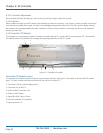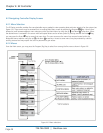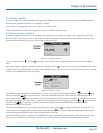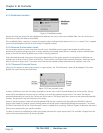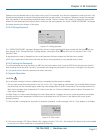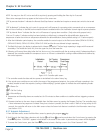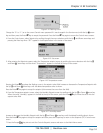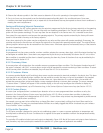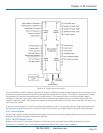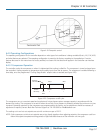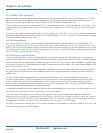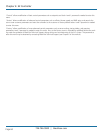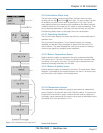
724-746-5500 | blackbox.com
Page 54
724-746-5500 | blackbox.com
Chapter 4: E2 Controller
8. Observe the indicator symbols in the Main screen to determine if the unit is operating in the required mode(s).
9. One to six hours may be required to see the desired temperature/humidity level in the conditioned space. Once room
conditions have been programmed or set, a repeat visit to the conditioned site may be required to ensure the air conditioner is
meeting the room's requirements.
Saving and Restoring Setpoint Parameters
Upon initial startup, the A/C system operates using the setpoints programmed by the factory (primary setpoints) as the operating
setpoints. As described in Section 4.3.1, the user may enter new operating parameters in the Control menu anytime and the
system will then operate accordingly. The user may store the new setpoints in the Service menu if it is intended to save them.
Once stored, the user setpoints now become the operating setpoints. The primary setpoints entered by the factory still remain
stored in the controller’s memory as the factory setpoints.
At any time, setpoints for the system may be re-adjusted to any value and the system will operate accordingly. If necessary, the
customer may enter the Service menu and restore the setpoints to the stored user operating setpoint values. The original Factory
(primary) setpoint values may also be restored from the Service menu. Whichever setpoints are restored (Factory or User) become
the current operating setpoints.
4.3.2 Alarms
As programmed into the system controller, an alarm condition activates the summary alarm logic, which illuminates the alarm key
and energizes an audible alarm. Some alarms are programmed by the factory to automatically shut down the A/C unit until the
alarm condition is remedied and the alarm is cleared by pressing the alarm key. Some of the alarms that may be enabled by the
factory are listed in Section 4.5.3.
4.3.2.1 Summary Alarm
A summary alarm will activate when the controller senses any programmed alarm condition. This illuminates the alarm key and if
the option is selected, a N.O./N.C. summary alarm contact may be energized for remote monitoring of alarm conditions. If certain
critical summary alarm conditions are detected, they will cause the A/C unit to shut down.
4.3.2.2 Customer Alarms
A customer-provided digital (on/off switching) alarm sensor may be connected to terminals provided in the electric box. This alarm
input may be for any site-specific alarm condition the user wishes to monitor that may or may not be provided in the standard
controller alarms menu; that is, Gas Detection, Intrusion Alarm, etc. Upon detection of a customer alarm, the controller will
activate the summary alarm contact and display a screen message indicating a customer alarm message. The screen message
“Customer Alarm 1” (default) will appear in the controller display, or the user may reconfigure the controller to display any
alphanumeric message desired, up to 20 characters long, in the Service>Options>Custom menu loop (see Section 4.5.5.5.).
4.3.2.3 Custom Alarms
A custom (user configured) alarm is activated upon detection of one or more programmed alarm conditions as set by the
operator in the Service>Options>Custom menu loop (see Section 4.5.5.5). When a custom alarm condition is detected, a
summary alarm is signaled and a designated set of N.O. & N.C. Custom Alarm relay contacts may be energized to provide remote
indication of the specific alarm condition(s).
For example, you may want to be notified when a change filter alarm is annunciated, notifying that the air filters need to be
cleaned or replaced. That way, you are alerted before the filters are so badly clogged that airflow is reduced to a point where a
“Loss of airflow” alarm is activated.
4.4 Controller Operation
The E2 Series controller is designed to control an air-conditioning system in a space or process application to temperature and
humidity levels as defined by the user. Conditioned air is supplied to the space as needed to maintain the temperature/humidity
control setpoints.
The controller I/O module includes inputs and outputs as depicted in Figure 4-18. Not all the inputs and outputs shown below are
used; therefore, only the inputs/outputs needed for the specific A/C system type and application are enabled.



